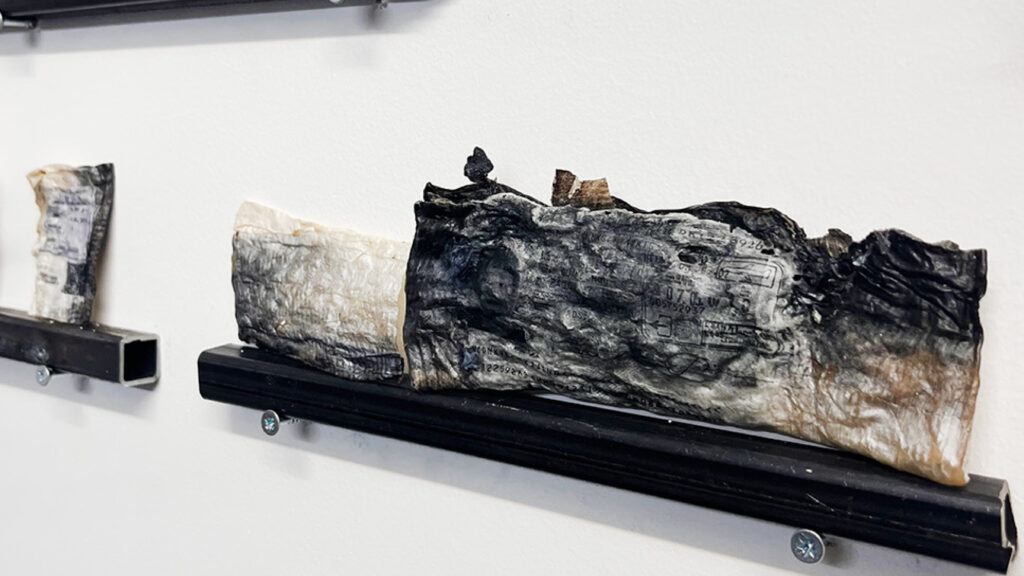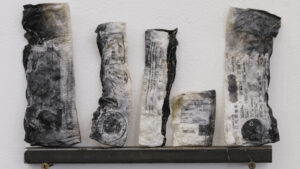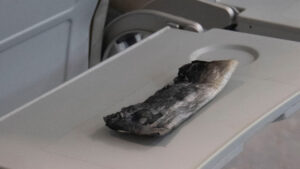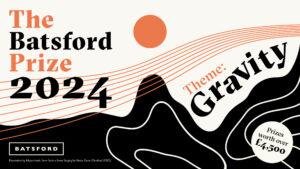ARTIST INTERVIEW: YE ZIJING BATSFORD PRIZE 2024 FINE ART WINNER

Here we get an inside look into the work of Ye Zijing, Fine Art Winner of The Batsford Prize 2024. Studying, Fine Art at The Slade School of Fine Arts, her work Breeding Migration made-in… responds to the 2024 theme of Gravity through angles of immigration.
Hi Ye! CAN YOU TELL US A LITTLE MORE ABOUT YOUR PIECE BREEDING-MIGRATION-MADE-IN…? WHAT IS IT YOU’RE TRYING TO SAY WITH YOUR WORK AND DOES THE FINAL PIECE DIFFER FROM THE ORIGINAL IDEA?
In Breeding-Migration-made in… I’m exploring the concept of freedom from a borderless perspective juxtaposed against the constraints experienced by farmed salmon. The idea is rooted in a scientific notion that our bodies regenerate all their cells every 7-10 years. Having lived in Japan for a decade, despite being a Chinese native, I find myself could physically be considered ‘made in Japan’ as my body has been nourished by Japanese ingredients. However, the reality of visa and immigration issues presents a stark contrast to this idea. The freedom of movement with Chinese nationality is significantly different from Japanese. It made me consider why are we so restrained. The piece delves into the paradox of identity and belonging. While my cells might be considered Japanese due to my diet and environment, my legal status is bound by my nationality. This contradiction highlights the tension between the freedom to relocate and the constraints of national identity.
In comparing this to farmed salmon, which are labelled and confined despite their nature, the work questions the reduction of individuals to singular classifications such as nationality. The final piece, while rooted in the original concept, evolved to more deeply challenge societal structures and provoke thought about the sustainability of national identity. It underscores the idea that while the quest for freedom is universal, it is often constrained by societal norms and structures, urging a reconsideration of our existential labels and the way we define ourselves.
WHO ARE YOUR PARTICULAR ARTIST INSPIRATIONS AND WHAT MOTIVATES YOU CREATIVELY?
Initially, Sophie Calle had a profound impact on me. I was particularly drawn to her ability to infuse deep emotion into her work, creating pieces that are both intimate and universally relatable. Calle’s exploration of personal narratives and the human experience resonated with me, pushing me to delve into the emotional depths of my own work. Recently, though, I’ve been really inspired by Hito Steyerl. Her work is fascinating because she delves deep into research, exploring the intersections of technology, politics, and society. What I love about Steyerl is how she uses her art to make complex topics accessible and thought-provoking. Her pieces often tackle issues like surveillance, the effects of globalisation, and how digital culture shapes our lives.
WHAT ARE YOUR PLANS AFTER YOU COMPLETE YOUR STUDIES?
In the short term, my primary goal is to obtain a Global Talent Visa in the UK, which will enable me to continue and expand my art journey here. With this visa, I plan to secure a working studio to have a dedicated space for my creative process. Additionally, I intend to apply for artist residencies around the world to gain diverse experiences and insights. This will allow me to immerse myself in various artistic communities, collaborate with fellow artists, and further refine my craft. These steps are crucial for my development as an artist and for building a global network in the art world.

WHAT LED YOU TO CREATE THIS PIECE IN THIS PARTICULAR MEDIUM?
The concept started from a fascinating scientific notion that our bodies regenerate all their cells every 7-10 years. Having lived in Japan for a decade, despite being a Chinese native, I realised that I am now physically ‘made in Japan’ as my body has been nourished by Japanese ingredients. This led me to think about borderless creatures in the world, with fish being a prime example. I intended to make the work entirely edible, which is why I used edible ink to print on rice paper and then transferred it to fish skin. I am currently in the process of extending this initial concept by gathering fish skin waste from local fishmongers to create a larger piece. This will likely become my degree show piece since the process of gathering fish skins is taking a very long time. Stay tuned for more developments!
WHY DID YOU WANT TO STUDY FINE ART AND WHAT IS IT ABOUT YOUR COURSE THAT YO THINK IS PARTICULARLY UNIQUE?
I wanted to study Fine Art because it is, in my view, the most liberating of all creative disciplines. Unlike other fields, Fine Art does not adhere to a fixed equation or standard. It offers a boundless platform for expressing my feelings, concerns, doubts, questions, and conflicts, allowing me to share my unique perspective with the world. Before joining The Slade School of Fine Art, I spent seven years studying in Japan. The curriculum there was quite different, with a strong emphasis on completing projects within strict timeframes, typically 1-2 months. This approach often limited deep exploration and prolonged experimentation in a single practice or study. What I find particularly unique about The Slade is its profound respect for each student’s individual process and experimentation. At Slade, there is a genuine encouragement to delve deeply into one’s artistic practice without the pressure of rigid deadlines, and without imposing an age limit. We have peers from all age groups, which creates a diverse and enriching environment. This inclusivity allows artists from all walks of life to engage, learn, and inspire one another, fostering a vibrant and supportive community where creativity can flourish.

WHAT DOES WINNING THE BATSFORD PRIZE MEAN TO YOU?
Winning the Batsford Prize is an incredible honour and a significant milestone in my journey, particularly as an international student who recently moved to this country. The recognition not only validates my artistic efforts but also provides me with immense support and confidence to continue pursuing my career in the arts. It’s a testament to the hard work I’ve put in and serves as a stepping stone toward obtaining a Global Talent Visa, which is crucial for my goal of extending my artistic journey in the UK. This award has truly empowered me to believe in my potential and to strive for greater achievements in the future.
IF YOU COULD HAVE CHOSEN THE THEME FOR THE BATSFORD PRIZE, WHAT WOULD YOU HAVE CHOSEN AND WHY?
If I could’ve chosen the theme for this year’s Batsford Prize, I would have gone with ‘Resilience’. In our rapidly changing world, resilience speaks to the human spirit’s ability to adapt, recover, and thrive despite challenges. Art has always been a powerful way to reflect on society’s struggles and victories, and ‘Resilience’ would encourage artists to explore stories of endurance and transformation. That said, I think ‘Gravity’ is a great theme too. It’s not just about the physical force that holds us down, but also the emotional and metaphorical weights we carry. ‘Gravity’ can inspire artists to look at balance, stability, and the invisible forces that shape our lives. Both themes are rich with potential, offering artists a chance to create deeply meaningful and thought-provoking work.
More of Ye Zijing’s work can be found on her website.

ABOUT THE BATSFORD PRIZE
The Batsford Prize is an annual award open for undergraduate and postgraduate students in the fields of applied art and textiles, fine art, illustration, children’s illustration and NEW for 2025, Architecture. View the winners and runners up of this year’s award. The theme for the Batsford Prize 2025 is Fun & Play.
Interviews for the other Batsford Prize 2024 winners are available to read here:

